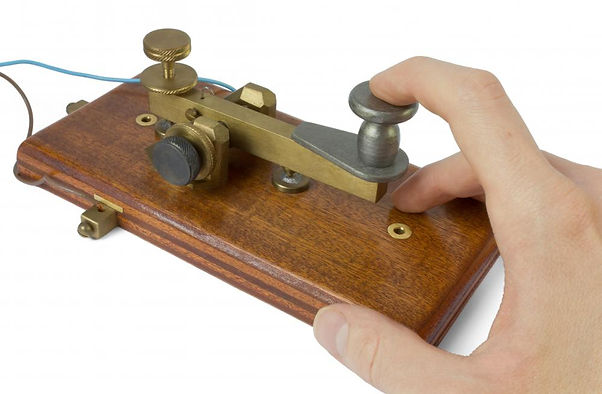
Telegraph
AMSCO p. 399
The telegraph. The first practical electric telegraph systems were created almost simultaneously in Britain and the United States in 1837. In the device developed by British inventors William Fothergill Cooke and Charles Wheatstone, needles on a mounting plate at a receiver pointed to specific letters or numbers when electric current passed through attached wires. American artist and inventor Samuel F.B. Morse created his own electric telegraph and, more famously, a universal code, since known as Morse Code, that could be used in any system of telegraphy. The code, consisting of a set of symbolic dots, dashes, and spaces, was soon adopted (in modified form to accommodate diacritics) throughout the world. A demonstration telegraph line between Washington, D.C., and Baltimore, Maryland, was completed in 1844. The first message sent on it was, “What hath God wrought!” Telegraph cables were first laid across the English Channel in 1851 and across the Atlantic Ocean in 1858. In the United States the spread of telegraphic communication through the growth of private telegraph companies such as Western Union aided the maintenance of law and order in the Western territories and the control of traffic on the railroads. What’s more, it enabled the transmission of national and international news through wire services such as the Associated Press. In 1896 Italian physicist and inventor Guglielmo Marconi perfected a system of wireless telegraphy (radiotelegraphy) that had important military applications in the 20th century.
The electric telegraph was an important invention born out of Joseph Henry’s electromagnetic motor. The idea is to generate a coded electric signal at one location, send it through a wire over a long distance, and decode the message at a distant location. This was first efficiently accomplished by sending electrical pulses that caused an electromagnet to rotate and strike a bell (Bellis "Telegraph"). Samuel Morse improved Henry’s design and made the electrical telegraph more practical and commercialized. Morse’s design made the electromagnet move to make markings on a sheet of paper, which could be decoded according to Morse code to decipher the message. He sent the inaugural telegraph message from Washington to Baltimore in 1844.
The telegraph was a revolutionary method of communication. Previous telegraph systems required visual contact between the two locations and the waving of flags to send messages, or people had to literally deliver the message via vehicle. The electric telegraph trumped both these systems: it worked over long distances that could be separated by visual barriers, and it was essentially instantaneous. Telegraph lines were built alongside railroads, allowing for convenient communication between the frontier railroad workers and the management, who usually stayed back east (Railroad Telegrapher).
Bellis, M. (2014, April 9). The History of the Telegraph - Samuel Morse. About.com Inventors. Retrieved April 11, 2014, from http://inventors.about.com/od/tstartinventions/a/telegraph.htm